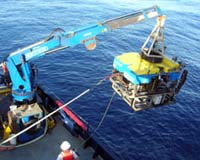 |
Eugene OR (SPX) May 10, 2011 High in the sky, water in clouds can act as a temptress to lure airborne pollutants such as sulfur dioxide into reactive aqueous particulates. Although this behavior is not incorporated into today's climate-modeling scenarios, emerging research from the University of Oregon provides evidence that it should be. The role of sulfur dioxide - a pollutant of volcanic gasses and many combustion processes - in acid rain is well known, but how sulfur dioxide reacts at the surface of aqueous particulates in the atmosphere to form acid rain is far from understood. In National Science Foundation-funded laboratory experiments at the UO, chemistry doctoral student Stephanie T. Ota examined the behavior of sulfur dioxide as it approaches and adsorbs onto water at low temperatures that mimic high-atmospheric conditions. Using a combination of short-pulsed infrared and visible laser beams, she monitored the interaction of sulfur dioxide with water as it is flowed over a water surface. The results - detailed online ahead of regular publication in the Journal of the American Chemical Society - show that as sulfur dioxide molecules approach the surface of water, they are captured by the top-most surface water molecules, an effect that is enhanced at cold temperatures. Although this reaching out, says co-author Geraldine L. Richmond, professor of chemistry, provides a doorway for sulfur dioxide to enter the water solution, the weak nature of the surface-bonding interaction doesn't guarantee that the water temptress will be successful. "We have found that that the sulfur dioxide bonding to the surface is highly reversible and does not necessarily provide the open doorway that might be expected," Ota said. "For example, for highly acidic water, the sulfur dioxide approaches and bonds to the water surface but shows little interest in going any further into the bulk water." The uptake of gases like sulfur dioxide has important implications in understanding airborne pollutants and their role in global warming and climate change. Sulfur dioxide that has come together with water, becoming aqueous, reflects light coming toward the planet, while carbon dioxide accumulating in the atmosphere traps heat onto the planet. Understanding the interaction of surface water molecules, such as those in clouds and fog, with pollutants rising from human activity below may help scientists better predict potential chemical reactions occurring in the atmosphere and their impacts, said Richmond, who was elected May 3 as a member of the National Academy of Sciences. "In the past we presumed that most chemistry in the atmosphere occurred when gas molecules collide and react," she said. "These studies are some of the first to provide molecular insights into what happens when an atmospherically important gas such as sulfur dioxide collides with a water surface, and the role that water plays in playing the temptress to foster reactivity."
Share This Article With Planet Earth
Related Links Space Technology News - Applications and Research
 'Fool's Gold' from the deep is fertilizer for ocean life
'Fool's Gold' from the deep is fertilizer for ocean lifeWashington DC (SPX) May 10, 2011 Similar to humans, the bacteria and tiny plants living in the ocean need iron for energy and growth. But their situation is quite different from ours--for one, they can't turn to natural iron sources like leafy greens or red meat for a pick-me-up. So, from where does their iron come? New research results published in the current issue of the journal Nature Geoscience point to a sourc ... read more |
|
| The content herein, unless otherwise known to be public domain, are Copyright 1995-2010 - SpaceDaily. AFP and UPI Wire Stories are copyright Agence France-Presse and United Press International. ESA Portal Reports are copyright European Space Agency. All NASA sourced material is public domain. Additional copyrights may apply in whole or part to other bona fide parties. Advertising does not imply endorsement,agreement or approval of any opinions, statements or information provided by SpaceDaily on any Web page published or hosted by SpaceDaily. Privacy Statement |